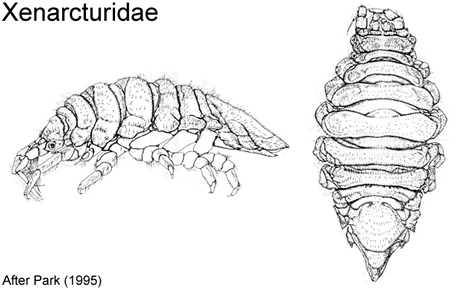 |
||||||
|
|
|
|
|
|
Australian Isopoda: FamiliesS.J. Keable, G.C.B. Poore & G.D.F. WilsonXenarcturidae Sheppard, 1957 Xenarcturidae Sheppard, 1957: 182. - Poore, 2001b: 226. Description. Body. Body shape without loss or gross modification of appendages on one side of the body; in dorsal view without peduncular articles of antenna 1 or 2 contiguous with coxal margins; in lateral view strongly vaulted. Body surface setose, not tuberculate. Head. Head not capable of lateral rotation (laterally encompassed, abutting or fused to pereonite 1); fused to pereonite 1. Eyes well developed. Antenna 1 inserting on head anteriorly and/or dorsally to antenna 2, minute or well developed; not as follows: reduced to 2 articles with second article expanded and scalloped. Antenna 2 well developed; flagellum of 2-3 articles plus distal claw. Mouthparts not forming suctorial cone or proboscis; with pereopod 1 visible in lateral view. Mandible not projecting anteriorly and together forceps-like; palp absent. Pereon. Pereonite 4 of similar length to pereonite 3. Pereonites 6-7 pereonite 7 distinct dorsally, free. Coxae extending ventrally and laterally to overhang the coxa-basis articulation of the pereopods; 2-7 more or less ventrally expanded over bases of pereopods. Oostegites 1-4 functional, 5 absent; 1-4 not supported by mesial coxal lobes. Pereopods 6-7 pairs readily apparent; 1-3 or 1-7 not prehensile; 1 a gnathopod, 2-3 elongated, differentiated from ambulatory 4-7; without dense fur of fine setae in males. Pereopod 1 dactylus evenly curved along anterior margin, evenly tapering. Pereopods 2-3 with scattered long setae along posterior margins; 2-4 dactylus prominent, unguis short. Pereopod 4 different from pereopod 3, similar to pereopod 5. Pereopods 5-7 without flattened setose articles andor dactyls modified or absent. Penes fused as a single penial plate; penial plate apically simple or barely slit. Pleon / Pleotelson. Pleonites and pleotelson with pleonites 1-5 and pleotelson fused. Pleopods 5 pairs present. Pleopod 1 peduncle longer than peduncle on pleopods 2-5; marginal setae on rami longer than, or equal to, length of rami; exopod of males thickened and with groove on posterior face, with groove on posterior face ending on tapering distolateral apical extension, lateral margin straight, with few simple setae. Pleopod 2 of males not consisting of an enlarged peduncle with a geniculate endopod and a small muscular exopod; appendix masculina about as long as endopod, basally less than half width of endopod. Pleotelson without dorsolateral ridges ending in mediodorsal posterior spine. Uropods positioned proximally on pleotelson; folded ventrally below pleotelson, forming operculum enclosing pleopodal chamber. Peduncle not forming an elongate clavate article with rami reduced or absent. Endopod not claw-like (acute and recurved) andor posteroventral in position. Exopod not folded dorsally over pleotelson, tapering, with terminal setae only, more than half as long as endopod. Distribution and generic composition. Monotypic. Xenarcturus spinulosus Sheppard, 1957 is known from Patagonia and Magellan Strait, 119-256m (Park, 1995).
Cite this publication as: 'S.J. Keable, G.C.B. Poore & G.D.F. Wilson (2002 onwards). 'Australian Isopoda: Families. Version: 2 October 2002. https://crustacea.net'. |
|
|
|
|
|
|
|
|
|
Copyright © Australian Museum, 2002 - 2003
Australian Museum website
